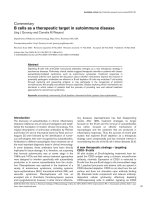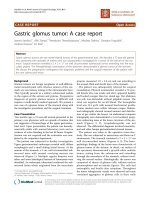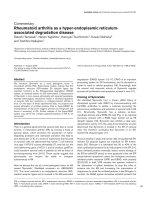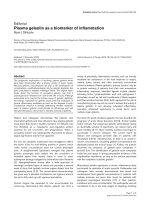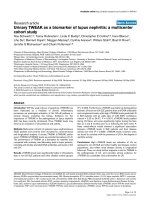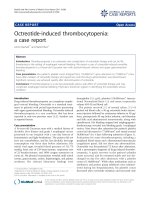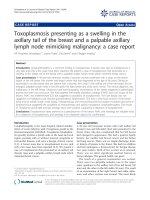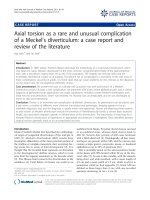Báo cáo y học: " Cholestatic hepatitis as a possible new side-effect of oxycodone: a case report" pptx
Bạn đang xem bản rút gọn của tài liệu. Xem và tải ngay bản đầy đủ của tài liệu tại đây (292.46 KB, 4 trang )
BioMed Central
Page 1 of 4
(page number not for citation purposes)
Journal of Medical Case Reports
Open Access
Case report
Cholestatic hepatitis as a possible new side-effect of oxycodone: a
case report
Vincent Ho*
1
, Maxwell Stewart
†2
and Peter Boyd
†3
Address:
1
School of Medicine, James Cook University, Cairns Base Hospital, Cairns, Queensland, 4870, Australia,
2
Department of Pathology,
Cairns Base Hospital, Cairns, Queensland, 4870, Australia and
3
Department of Gastroenterology, Cairns Base Hospital, Cairns, Queensland, 4870,
Australia
Email: Vincent Ho* - ; Maxwell Stewart - ;
Peter Boyd -
* Corresponding author †Equal contributors
Abstract
Introduction: Oxycodone is a widely-used semisynthetic opioid analgesic that has been used for
over eighty years. Oxycodone is known to cause side effects such as nausea, pruritus, dizziness,
constipation and somnolence. As far as we are aware cholestatic hepatitis as a result of oxycodone
use has not been reported so far in the world literature.
Case presentation: A 34-year-old male presented with cholestatic jaundice and severe pruritus
after receiving oxycodone for analgesia post-T11 vertebrectomy. Extensive laboratory
investigations and imaging studies did not reveal any other obvious cause for his jaundice and a liver
biopsy confirmed canalicular cholestatis suggestive of drug-induced hepatotoxicity. The patient's
symptoms and transaminases normalised on withdrawal of oxycodone confirming that oxycodone
was the probable cause of the patient's hepatotoxicity.
Conclusion: We conclude that cholestatic hepatitis is possibly a rare side effect of oxycodone use.
Physicians should be aware of the possibility of this potentially serious picture of drug-induced
hepatotoxicity.
Introduction
Medications are a common cause of hepatic injury which
is not surprising as the liver is the predominant site of
drug clearance, biotransformation and excretion. Oxyco-
done is a widely used semi-synthetic opioid that has been
an effective analgesic agent for the last eighty years. Oxy-
codone has well-described side effects which include nau-
sea, pruritus, dizziness, constipation and somnolence.
Hepatic injury as a result of oxycodone use however has to
date not been reported in the world literature.
We report a patient who experienced jaundice and pruri-
tus after taking oxycodone after a T-11 vertebrectomy,
with a clinical presentation and liver histology highly sug-
gestive of oxycodone-induced cholestatic hepatitis.
Case presentation
A 34-year-old man presented in May 2006 for an elective
T11 vertebrectomy after a prior motor vehicle accident
injury in 2004. His only pre-existing medication was Tra-
madol 200 mgs daily for analgesia. Pre-admission blood
tests were normal.
Published: 1 May 2008
Journal of Medical Case Reports 2008, 2:140 doi:10.1186/1752-1947-2-140
Received: 12 June 2007
Accepted: 1 May 2008
This article is available from: />© 2008 Ho et al; licensee BioMed Central Ltd.
This is an Open Access article distributed under the terms of the Creative Commons Attribution License ( />),
which permits unrestricted use, distribution, and reproduction in any medium, provided the original work is properly cited.
Journal of Medical Case Reports 2008, 2:140 />Page 2 of 4
(page number not for citation purposes)
At the time of operation he received 20 ml 0.5% Bupi-
vacaine with adrenaline for local anaesthesia with 1 g
Cephalothin administered for antibiotic prophylaxis. Pro-
pofol 860 mgs and Fentanyl 3000 micrograms were given
as an infusion during and after the operation. Ketamine
600 mgs was administered via intravenous infusions for
analgesia. The infusions were discontinued after 3 days.
Blood tests at that point including liver enzymes were nor-
mal.
After the discontinuation of his pain infusions he was
started on short acting oxycodone for analgesia. Three
days after receiving a total of 40 mg of oxycodone, routine
liver enzyme tests revealed bilirubin 8 µmol/L (<20 µmol/
L), ALP 229 u/L (40–110 u/L), GGT 283 u/L (<50 u/L),
ALT 78 u/L (<45 u/L) and AST 86 u/L (<40 u/L). He was
asymptomatic. His liver dysfunction was attributed to the
earlier combination of anaesthetic agents with analgesics
and thought to be transient. Controlled release oxyco-
done was commenced and titrated with short acting oxy-
codone breakthrough to 40 mg oxycodone in the
morning and 20 mg at night. He was discharged pain-free.
He represented to our hospital eight weeks later because
of painless jaundice and debilitating generalised pruritus
which had been present for the last two weeks. He had
been taking only controlled release oxycodone at the
doses of 40 mg in the morning and 20 mg at night every
day since his prior hospital discharge. He had not taken
any other medications since discharge including over-the-
counter medications, herbal or traditional medicines. His
admission bilirubin level was recorded at 140 µmol/L
(<20 µmol/L), ALP 358 u/L (40–110 u/L), GGT 54 u/L
(<50 u/L), ALT 295 u/L (<45 u/L) and AST 149 u/L (<40
u/L).
He had never consumed alcohol and there was no recent
travel history. Viral serology for hepatitis and HIV were
negative. An infectious screen was carried out as Far North
Queensland has a high incidence of exotic illnesses that
can cause transient liver enzyme derangement. CMV, EBV,
Spotted fever, Scrub Typhus, Flavivirus, Dengue, Ross
River, Barmah Forest and Leptospirosis serology were all
unremarkable.
A liver screen carried out including serum copper and
caeruloplasmin, α-fetoprotein, α-1 antitrypsin, iron stud-
ies, ANA, ANCA, anti-LKM1, anti-mitochondrial and anti-
smooth muscle antibodies were unremarkable. Complete
blood count was normal.
Abdominal ultrasound revealed the presence of a gall-
bladder full of calculi. No dilatation of the common bile
duct or intrahepatic ducts was seen.
On CT cholangiogram the contrast material was noted to
be excreted by the renal tract suggesting that the pathology
lay at the hepatocellular level rather than ductal obstruc-
tion. A magnetic resonance cholangiopancreatography
confirmed the presence of gallstones but was otherwise
unremarkable with no ductal dilatation.
A liver biopsy was performed and was striking for the pres-
ence of canalicular cholestasis with bile plugs in dilated
canaliculi (figure 1). Occasional portal tracts contained a
prominent lymphocytic infiltrate with mild piecemeal
necrosis.
On withdrawal of oxycodone his liver function tests
improved. One day after stopping his oxycodone his
bilirubin level was 138 µmol/L (<20 µmol/L), ALP 188 u/
L (40–110 u/L), GGT 34 u/L (<50 u/L), ALT 59 u/L (<45
u/L) and AST 53 u/L (<40 u/L).
One month after cessation his bilirubin level had fallen to
42 µmol/L (<20 µmol/L), ALP 140 u/L (40–110 u/L),
GGT 34 u/L (<50 u/L), ALT 127 u/L (<45 u/L) and AST
100 u/L (<40 u/L). His liver function tests 6 months post-
cessation of oxycodone are in the normal range and jaun-
dice and pruritus have completely resolved.
Discussion
Oxycodone is a widely used semi-synthetic opioid analge-
sic derived from the opium alkaloid thebaine. Compared
with morphine, oxycodone has a higher oral bioavailabil-
ity and is about twice as potent [1]. Oxycodone is metab-
olized by demethylation to noroxycodone and
oxymorphone followed by glucuronidation [2].
Liver biopsy image: bile thrombi (brown pigment) in dilated canaliculi is seen resulting in canalicular stasisFigure 1
Liver biopsy image: bile thrombi (brown pigment) in dilated
canaliculi is seen resulting in canalicular stasis.
Journal of Medical Case Reports 2008, 2:140 />Page 3 of 4
(page number not for citation purposes)
Frequent side-effects of oxycodone include nausea, pruri-
tus, dizziness, constipation and somnolence. Less fre-
quent but serious side effects include hypotension and
respiratory depression.
Cholestasis is associated with altered opioidergic neuro-
transmission and this is demonstrated through a number
of lines of evidence. Firstly there is an opiate withdrawal-
like reaction that patients with cholestasis can experience
after the administration of opiate antagonists [3]. Sec-
ondly, increased plasma concentrations of some opioid
peptides have been demonstrated in patients with
cholestasis and in an animal model of cholestasis [4].
Hepatocytes have been shown to increase mRNA for met-
and leu-enkephalins, suggesting the liver as a source of
these opioids [5]. Finally the down-regulation of central
opioid receptors has been shown in the brain of rats with
cholestasis [6].
Morphine has been clearly linked to cholestatic pruritus
and altered central opioidergic tone via the mu receptor
pathway is thought to be a contributing cause [7]. That the
pruritus of cholestasis is mediated, at least in part, by
endogenous opioids, is supported by the observation that
pruritus can be ameliorated by opiate antagonists. The
precise mechanism for how morphine can cause choles-
tatic pruritus is however yet to be elucidated.
Oxycodone shares similar pharmacodynamic properties
to morphine and displays binding to the mu-1 and kappa
receptors, hence its use may result in cholestatic pruritus
via increased central opioidergic tone [8].
To our knowledge no case of cholestatic hepatitis during
oxycodone use has been reported. In our case the patient
did have exposure to a number of anaesthetic and analge-
sic agents in his first admission which could have contrib-
uted to hepatotoxicity. However the persistence and
exacerbation of his elevated liver enzymes and the mani-
festation of symptoms on oxycodone alone suggests that
it is the probable cause of hepatotoxicity. Extrahepatic bil-
iary pathology was deemed unlikely to result in his clini-
cal picture in the absence of ductal dilatation on multiple
imaging modalities. Liver biopsy showed features consist-
ent with drug-induced inflammatory intrahepatic
cholestasis and other diseases of the liver were excluded.
Importantly, discontinuation of oxycodone led to a reso-
lution of symptoms and a gradual but progressive return
to normality on liver enzyme tests.
A Naranjo probability scale [9] utilised in our case scored
6 consistent with a probable adverse drug reaction. A
more specific clinical scale for hepatotoxicity was likewise
consistent with probable hepatotoxicity from oxycodone,
with a RUCAM score of 7 [10]. Notification has been sub-
mitted to the Australian Adverse Drug Reactions Advisory
Committee (ADRAC).
We did not consider rechallenging our patient with oxyco-
done due to ethical concerns as he was symptom free and
there was a considerable risk of inducing fulminant
hepatic failure.
Conclusion
In summary, we report a potential case of cholestatic hep-
atitis as a consequence of oxycodone use. As far as we are
aware this is the first report in literature to document pos-
sible hepatotoxicity from oxycodone use. As oxycodone is
a widely used opioid analgesic physicians should be
aware of the possibility of this rare but potentially serious
adverse drug reaction.
Competing interests
The authors declare that they have no competing interests.
Authors' contributions
VH collated the information from the medical file and
was the treating registrar. MS carried out the histopatho-
logical examination of the biopsy specimen. PB as the
consultant-in-charge of the case made the provisional
diagnosis of oxycodone-induced cholestatic hepatitis. All
authors read and approved the final manuscript.
Consent
Written informed consent was obtained from the patient
for publication of study and any accompanying images. A
copy of the consent is available for review by the Editor-
in-Chief of this journal.
References
1. Davis MP, Varga J, Dickerson D, Walsh D, LeGrand SB, Lagman R:
Normal-release and controlled-release oxycodone: pharma-
cokinetics, pharmacodynamics, and controversy. Support Care
Cancer 2003, 11(2):84-92.
2. Weinstein SH, Gaylord JC: Determination of oxycodone in
plasma and identification of a major metabolite. J Pharm Sci
1979, 68(4):527-528.
3. Bergasa NV, Schmitt JM, Talbot TL, Alling DW, Swain MG, Turner
ML, Jenkins JB, Jones EA: Open-label trial of oral nalmefene
therapy for the pruritus of cholestasis. Hepatology 1998,
27(3):679-684.
4. Thornton JR, Losowsky MS: Opioid peptides and primary biliary
cirrhosis. BMJ 1988, 297(6662):1501-1504.
5. Bergasa NV, Vergalla J, Swain MG, Jones EA: Hepatic concentra-
tions of proenkephalin-derived opioids are increased in a rat
model of cholestasis. Liver 1996, 16(5):298-302.
6. Bergasa NV, Rothman RB, Vergalla J, Xu H, Swain MG, Jones EA:
Central mu-opioid receptors are down regulated in a rat
model of cholestasis. J Hepatol 1992, 15(1–2):220-224.
7. Bergasa NV: The pruritus of cholestasis. J Hepatol 2005,
43(6):1078-1088.
8. Lugo RA, Kern SE: The pharmacokinetics of oxycodone. Journal
of Pain and Palliative Care Pharmacotherapy 2004, 18(4):17-30.
9. Naranjo CA, Busto U, Sellers EM, Sandor P, Ruiz I, Roberts EA,
Janecek E, Domecq C, Greenblatt DJ: A method for estimating
the probability of adverse drug reactions. Clin Pharmacol Ther
1981, 30(2):239-45.
Publish with BioMed Central and every
scientist can read your work free of charge
"BioMed Central will be the most significant development for
disseminating the results of biomedical research in our lifetime."
Sir Paul Nurse, Cancer Research UK
Your research papers will be:
available free of charge to the entire biomedical community
peer reviewed and published immediately upon acceptance
cited in PubMed and archived on PubMed Central
yours — you keep the copyright
Submit your manuscript here:
/>BioMedcentral
Journal of Medical Case Reports 2008, 2:140 />Page 4 of 4
(page number not for citation purposes)
10. Danan G, Bénichou C: Causality assessment of adverse reac-
tions to drugs. I. A novel method based on the conclusions of
international consensus meetings: application to drug-
induced liver injuries. J Clin Epidemiol 1993, 46(11):1323-1330.

